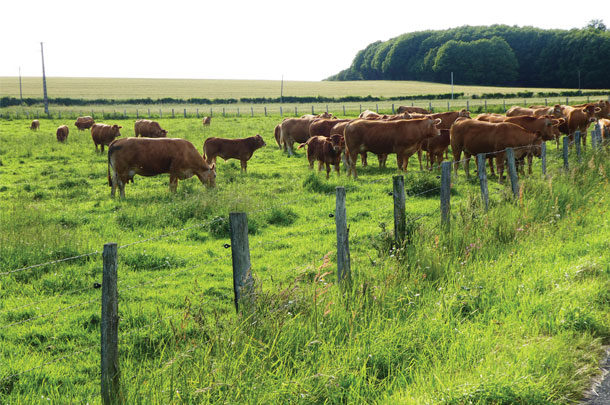Many cattle producers are geared to the excitement of genetics and successful calf crops, driven to improve and be the best cattle breeders possible.
Being of like mind, I understand the focus on cattle management, breeding and marketing. As the years have progressed, though, I have seen the missing link for our pursuit of cattle production excellence. It is something I have personally lacked and continue to strive to more accurately understand. When I get a call about a cattle issue from an extension agent or producer, there are some situations that are easy to predict. It’s a common issue and possibly the biggest problem in the cow-calf segment of the industry in many areas. Of every 10 calls I get, eight of them will typically have one similar link: (drum roll … dut … dutta … dut) poor grass management.
This comes as no surprise, and I realize some reading this may say, “Oh no, not again. Not another article about being a grass farmer.” Although being a “grass farmer” is a great objective and a correct term, it could also simply be termed “ranch manager.” If we are to be good ranch managers, soil and forage management should be the focal point for all other production aspects to be more successful.
Success in a beef cattle operation can mean many things but, ultimately, it is profitability driven by reproductive efficiency, cow cost, health and animal welfare. With those components in good order, marketing becomes more effortless. Success is something every cattle producer desires but often seems unreachable.
When a call about a cattle production issue comes my way, the first thing that hits my mind is short grass. It’s the one issue that stretches across almost every herd nutrition and health issue I’ve encountered. Picture in your mind grass shorter than a golf putting green and weeds taller than most calves.
This can unfortunately happen to anyone from time to time and during specific seasons or weather challenges, but hopefully the majority of the grass-growing season has sufficient growing forage and a manageable weed population. How is good grass management established? It seems that study, focus and time are the beginning ingredients. There are also a few bedrock truths that have stood the test of time.
Bedrock truth No. 1
First, soil pH is the crucial building block for all things forage management. I’m not a soil scientist and won’t pretend to be. This is one of the very valuable parts of a land-grant system’s extension program. They often have the information, labs and sometimes the collection tools to aid producers in getting a handle on current soil pH. A cattle operation’s focus on stabilizing soil pH is paramount to the success of the entire operation. Can soil pH affect fertility in the herd? Can soil pH affect lactation, calf growth, disease (including infertility) and cow cost? Ponder that for a few moments.
Soil pH is not the only factor but is the foundation for proper herd nutrition in the form of grazing and stored forages. Many forages grow best in soils with a pH from 6.0 to 6.5 but can vary slightly based on the forage being produced. After taking in soil samples gathered according to proper sampling recommendations, the results guide an individual operation on where to focus lime application, if any.
This, in turn, allows for more effective application of fertilizers. Fertilizer application without proper pH is a huge waste of time and money. With proper soil pH and adequate nitrogen, phosphorus and potassium, the forages in question have an optimum chance for production if weather cooperates and grazing is managed properly.
Bedrock truth No. 2
Overstocking or overgrazing often begins a steep downhill slide into reduced herd health and lower-quality herd nutrition with increased cost. No matter the pH and fertility of the soil, overgrazed forages are simply unable to provide adequate nutrition for females to do their job. Adding pain to misery, cow cost goes up as commodities and stored forage are often used to patch nutrient gaps. Short pastures in some environments also bring on heavier loads of the invisible production killers known as internal parasites.
The equation of poorer nutrition and greater parasite loads is not pleasant to observe. This situation can sneak up on those not focused on forages. No one ever intends to allow this to occur. However, about the second or third year of overgrazing, pregnancy checking ends with a 40% A.I. conception rate or a herd pregnancy rate of 75%. Circling the wagons, we ask “What happened? Was the bull bad? Is my A.I. tech slipping? Are my minerals not working?”
Overstocking has large and long-lasting impact. Growing grass is difficult to replace with respect to its quality and price. One helpful key to reduce overgrazing and lengthen the number of grazing days is rotational grazing.
Table 1 demonstrates research on stockpiled fescue conducted by Dr. Dennis Hancock and the University of Georgia forages team.

In this example, only 30% to 40% of forage is utilized in continuously stocked pastures versus 50% to 60% utilization when strategically grazing five to six paddocks. If improved grazing strategies increase the number of grazing days, feed cost should naturally go down.
The UGA forages team often reinforces the phrase “grass grows grass.” Focusing on grazing height and developing a grazing strategy can make all the difference in a herd’s fertility, productivity, health and profitability. A ranch manager’s soil is a living and breathing organism itself. It is either on the brink of death or developing into a flourishing environment that feeds your forages, your herd and your bank account.
There is a lot to learn regarding forage management, but it is without a doubt a necessary part of being a great ranch manager. ![]()
Getty Images.

-
Jason Duggin
- Beef Extension Specialist
- University of Georgia
- Email Jason Duggin












